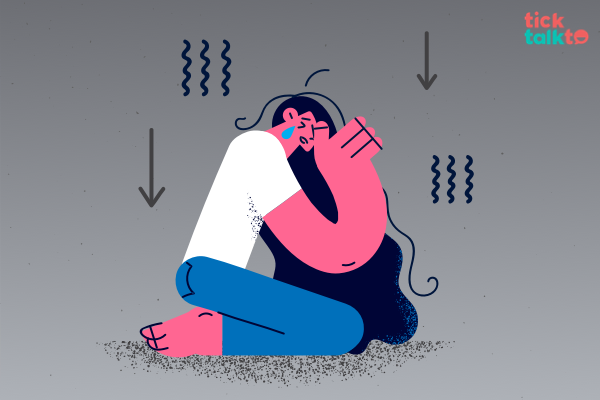How many times has it happened that you want to be helpful to a distressed friend and you end up saying…“relax, look at the bright side.”? A number of times, I am sure. We all have, at some point in life tried to make people see positive when they are feeling like they are going through an emotionally difficult time. Or you might be on the opposite side of the spectrum where you were told to “just be grateful for what you have”. Do you ever wonder if this is an effective way to reach the solution of complex emotional problems that we all go through?
When is thinking positive not a positive?
Let us do a thought experiment.
Imagine that the person you were dating broke up with you out of the blue, without a fight or cause. You have tried talking to them plenty of times but their interest has completely shifted and there is nothing you can do. You are feeling miserable, because after all this time that you have spent with them, you were hoping to go forward, perhaps into a committed relationship. You have been crying and feeling helpless and finally reach out to your well-meaning best friend. After spending some time consoling you she/he begins to make you see the positives of the situation. She/he might say “There will be other guys/girls”, or “the market is open for you”, or even turn vengeful and say something like “You can go do the same to someone else and at least enjoy yourself”. But there you are, with all these wonderful thoughts about your ex, with all the complicated emotions you have been carrying around, still helpless. Not that simple is it?
So what is happening to you in this moment and why is your friend not able to help you? To understand this we need to first understand negative emotions.
Negative Emotional States such as fear, anger, jealousy, disgust, shame and grief are those states which are unpleasant and cause us significant distress. Clearly, no one would ‘choose’ to be in a negative state, if they had the choice. Often times, they don’t, and the influx of these painful emotions is unstoppable, such as in the case of a blindsided breakup.
We’ve always felt at home with ‘thoughts’ and new ideas; we play with them every day. But emotions can seem like aliens inhabiting the body and mind. So many of us don’t know how to relate to them or what to do with them. As is the case with all psychological content, that which we can’t deal with often gets ‘swept under the rug’. And although this approach may seem to work in the short-term, over time repressing our emotions wreaks havoc on our mental, emotional, and physical wellbeing.
What Are Repressed Emotions?
Here is another thought experiment to understand repressed emotions.
Imagine a seven-year-old is doing homework at the kitchen table. His older brother storms in angrily, pushes his hand over the counter, sending the younger brother’s books flying to the floor. The seven-year-old is enraged, but he quickly sees the rage in his big brother’s eyes. He doesn’t want to get hit too, so he says nothing. Now, what happened to the younger brother’s rage? He doesn’t express it out of fear of the consequences. Instead, he suppresses it. That is, he pushes it down within him. If the boy is successful at pushing his rage away, very soon, he won’t even feel it anymore. (Perhaps he goes and plays video games instead). Does that mean the anger went away? Nope. It just indicates that the boy successfully repressed his rage out of his conscious awareness.
Repressed emotions can be expressed as:
• Denying feelings
• Ignoring feelings
• Avoiding communication
• Avoiding touch
• Distrust
How Repressed Emotions Affect the Body
Psychoanalyst Wilhelm Reich observed the effects repressed emotions had on the body, calling it ‘body armour’. According to him, as we accumulate emotional trauma in childhood, to adapt to our environment, our bodies (and character) begin shielding us from additional emotional pain. This armour hinders our ability to connect with and heal old emotional wounds and experience the resulting release from this process.
Emotions and the unconscious are also expressed immediately in bodily action and imaginary symbolization, not only at the verbal/conceptual level. Your overall emotional and mental health is directly linked to your physical health. Repressed anger or other negative emotions may be tied to a higher risk for things like:
• Depression
• High blood pressure
• Heart disease
• Digestive problems
• Infections
• Low energy
• Pain
You might also have problems in your relationships. You might have problems with:
• Saying what you need
• Facing conflict
• Feeling connected and intimate with others
Connected psychological issues can include:
• you can feel low and tired for no real reason, or are mildly depressed1
• you experience low-level anxiety or on-going stress2
• you suffer from low self-esteem3
• your mind is foggy and unclear, you can be forgetful and absent-minded
• you use self-destructive behaviours, such as overeating4 and drinking too much5
• you struggle with weight issues6
• you might suffer constant flus and cold (low immune system)
• you have sleep problems7
Signs That You Might Be Repressing Your Emotions
Patterns of thinking:
- You believe negative emotions are something bad, weak, or embarrassing.
- You believe negative emotions should not be expressed.
- You believe that you never struggle with negative emotions and describe yourself as feeling ‘fine.’
Patterns of behaving and relating to yourself:
- You ignore and push away negative thoughts and emotions.
- You avoid and distract from your negative thoughts and emotions by turning toward numbing and escaping behaviors such as drinking and using substances, binge eating, binge watching netflix, playing computer games for hours, or overworking.
- You find it difficult to recognize and admit that things in your life are harming you.
- You find yourself at times erupting because of built-up emotions.
- You focus more on your physical wellbeing.
Patterns of behaving and relating to others:
- You generally do not like to be asked how you feel.
- You put on a positive front in front of others and do not express negative emotions.
- You get along well with people but struggle with emotional intimacy and close friendships.
- You feel uncomfortable with and struggle to tolerate people who are emotional and express negativity, and you try to shift focus to the positive.
Adaptive emotional processing
- The best way to learn to take charge of your emotions is to see a licensed therapist. They can help you understand your feelings. They can also teach you ways to manage conflict and communicate better.
- Understanding how you relate to your emotions: What you think about negative emotions will influence how you feel about them and how you behave and respond to them. For instance, if you think that negative emotions are an inconvenience and a sign of weakness, you may feel frustrated when you or others experience them, leading you to push them away.
- Educating yourself about emotions: What is the point of having emotions? What are the different positive and negative emotions designed for?
- Understanding how emotions show up in your body: To cope with emotions, you need to understand how emotions manifest in your body. Different emotions show up differently in your body, and this varies from person to person.
- Learning the triggers to your emotions: Understanding the triggers can equip us to be prepared for particular emotions to show up and enable us to manage them more effectively. For example, if I know that speaking in a meeting typically makes me feel anxious, I can take a few moments to calm my anxiety by taking 10 deep breaths.
- Learning how to live with your emotions: If we don’t push our emotions away, they won’t push back, and we can live with them more easily.
- Acknowledging your emotions: It can be helpful to learn how to acknowledge and validate your emotions. You can do this by naming them (e.g., ‘here is anger’; ‘anxiety is back’), without judging yourself or giving yourself a hard time for experiencing them.
- Sitting with your emotions: Sitting with negative emotions means being with them when they show up by observing them and focusing your attention inward on the body’s sensations. For example, you may focus on the butterflies in your stomach when you start to feel anxious.
- Choosing a helpful action: Once you understand the message, you can then choose whether you need to take action and, if you do, what action will be helpful to yourself and others. The action will vary based on the circumstances and may include:
- Finding a solution to the problem and acting on it
- Tolerating the emotion until it passes if it is a false alarm
- Being kind to yourself
- Soothing your body through breathing
- Participating fully in the activity you are doing, such as cooking, playing with your child, or exercising
A take home message
You will experience positive and negative emotions throughout your life; that is the deal that comes with being human. The bottom line is that emotions are not the enemy. We need them, and they help us survive. Our interpretation and perception of emotions as bad and wrong, together with not having the right tools to cope, are the problems to focus on.

 Mihul Narad
Mihul Narad


